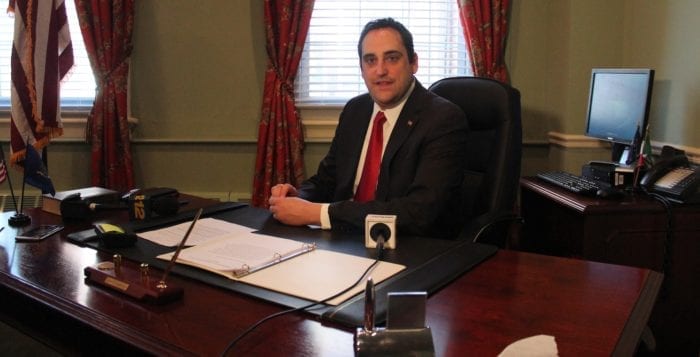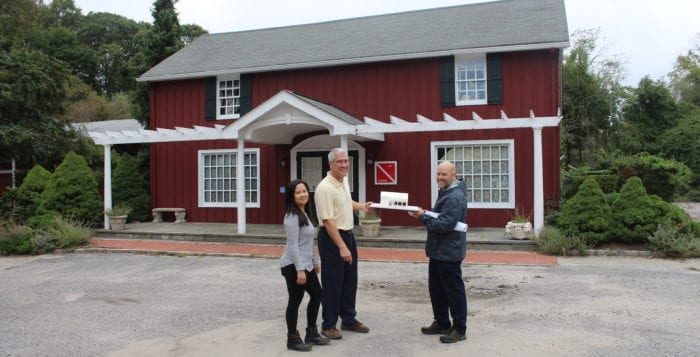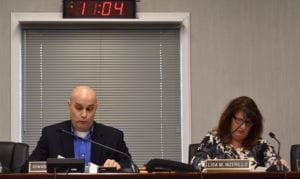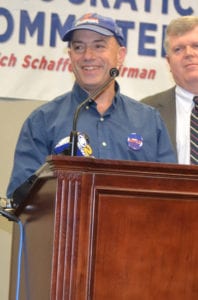Town of Huntington officials made the decision Tuesday to take Long Island Power Authority’s proclaimed value of the Northport Power Station at $193 million as an invitation to investigate purchasing the facility.
Huntington town board approved a resolution offered by Councilman Gene Cook (I) to authorize the town attorney’s office to formally research into its legal options in utilizing eminent domain to take ownership of the Northport plant by a 4-1 vote.
“It’s for the people, to look out for the future of the Town of Huntington,” he said. “I have done a lot of research and I believe it’s the right thing to do.”
“It’s for the people, to look out for the future of the Town of Huntington.”
— Gene Cook
The councilman first raised the possibility of turning to eminent domain back in May, days after LIPA submitted documents to Suffolk County Supreme Court in its pending tax certiorari lawsuit against the town, which disputes the current annual tax-assessed value of the plant at about $80 million. The utility company has alleged the structure only has a fair market value of $193,680,000 as of July 1, 2013, based on a market value report from Tarrytown-based Tulis Wilkes Huff & Geiger.
“I looked at that appraisal not as a fair evaluation, but an invitation for the town to explore condemnation of the plant,” Councilman Ed Smyth (R) said. “The price is so ridiculously low that it would be negligent of us to not explore the possibility of acquiring the plant.”
Smyth said that he believes the Northport Power Station, which is actually owned by National Grid, is underutilized by LIPA, perhaps intentionally to devalue it given the ongoing tax certiorari lawsuit.
Cook had previously stated he believes the Northport facility is one of the largest power plants in the Northeast and will become more valuable with future improvements. He said his research shows the facility has the potential to operate and generate electric for another 15 to 30 years, up to a maximum of 40 years before closing down. Cook previously estimated the power station could produce as much as $5 billion in revenue per year for the town.
“The price is so ridiculously low that it would be negligent of us to not explore the possibility of acquiring the plant.”
— Ed Smyth
“What I like if the town buys it now at this rate is, when the plant is closed, we could shut it down and give the property back to the people for reaction or environmental uses,” he said.
Councilman Mark Cuthbertson (D) was the lone vote against an official resolution requesting the town attorney’s office to conduct research into the possibility of eminent domain. He called the legislation an unnecessary act of “grandstanding,” stating any board member could have simply verbally requested the town attorney to look into the matter.
“We are creating false hope this is a viable option, if it really were an option our lawyers would have suggested it a long time ago,” he said. “It is not a possibility to operate the LIPA plant as municipal power authority.”
The councilman also stated that under New York State General Municipal Law, if the town were to take over daily operation of the power station it would not pay any taxes to the Northport-East Northport School District — which currently receives approximately $56 million annually from the utility company.
If the town were to initiate the process of obtaining the power plan via eminent domain, it would not resolve the town’s lawsuit with LIPA. In addition to seeking a 90 percent reduction of taxes on the power plant, LIPA is asking for the town to reimburse it for alleged overpayment of taxes each year since it filed the claim in 2010 — totaling more than $500 million.
“We are creating false hope this is a viable option, if it really were an option our lawyers would have suggested it a long time ago.”
— Mark Cuthbertson
Sid Nathan, spokesman for LIPA, said the company had no comment as it is continuing negotiations at this time.
Huntington, Northport-East Northport school district, LIPA and National Grid all agreed to sit down with neutral third-party mediator, Port Washington-based attorney Marty Scheinman, in nonbinding arbitration this July to see if all parties could reach a potential settlement agreement over the tax-assessed value of the Northport plant. The trial on the tax certiorari case is scheduled to continue in February 2019, according to Cook.
Tom Kehoe, deputy mayor for the Village of Northport, commended Cook and the town board for their decision to move forward with investigating the legal potential of utilizing eminent domain to take over the plant.
“Whether it ever gets to the point of the town acquiring it through eminent domain, it’s another piece of the puzzle that will put a little pressure on the utility and LIPA to come to an agreement that’s good for all of us,” Kehoe said.


















